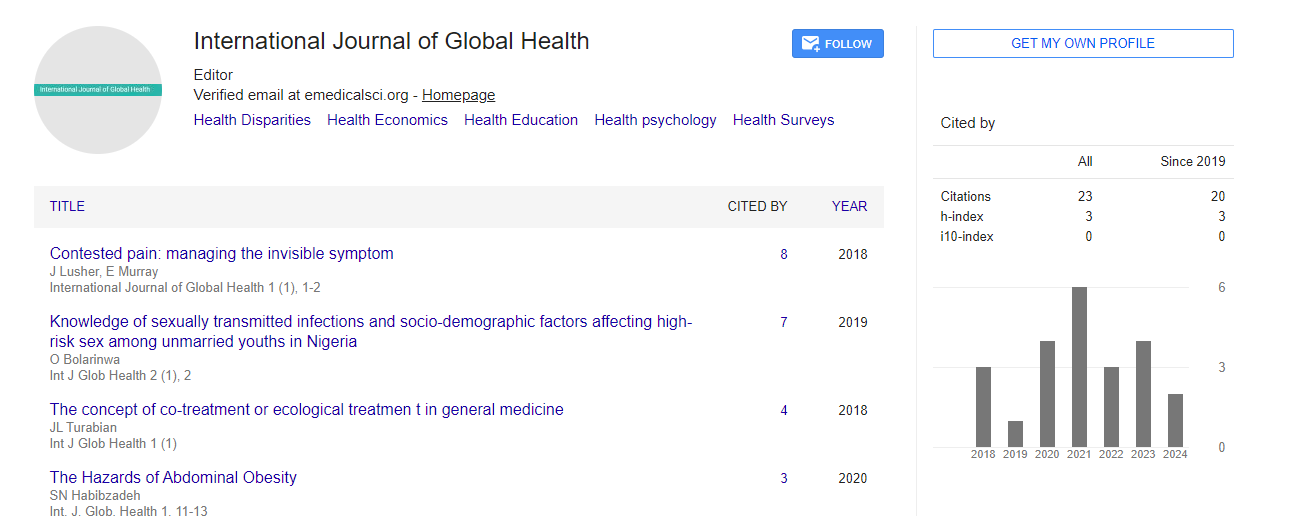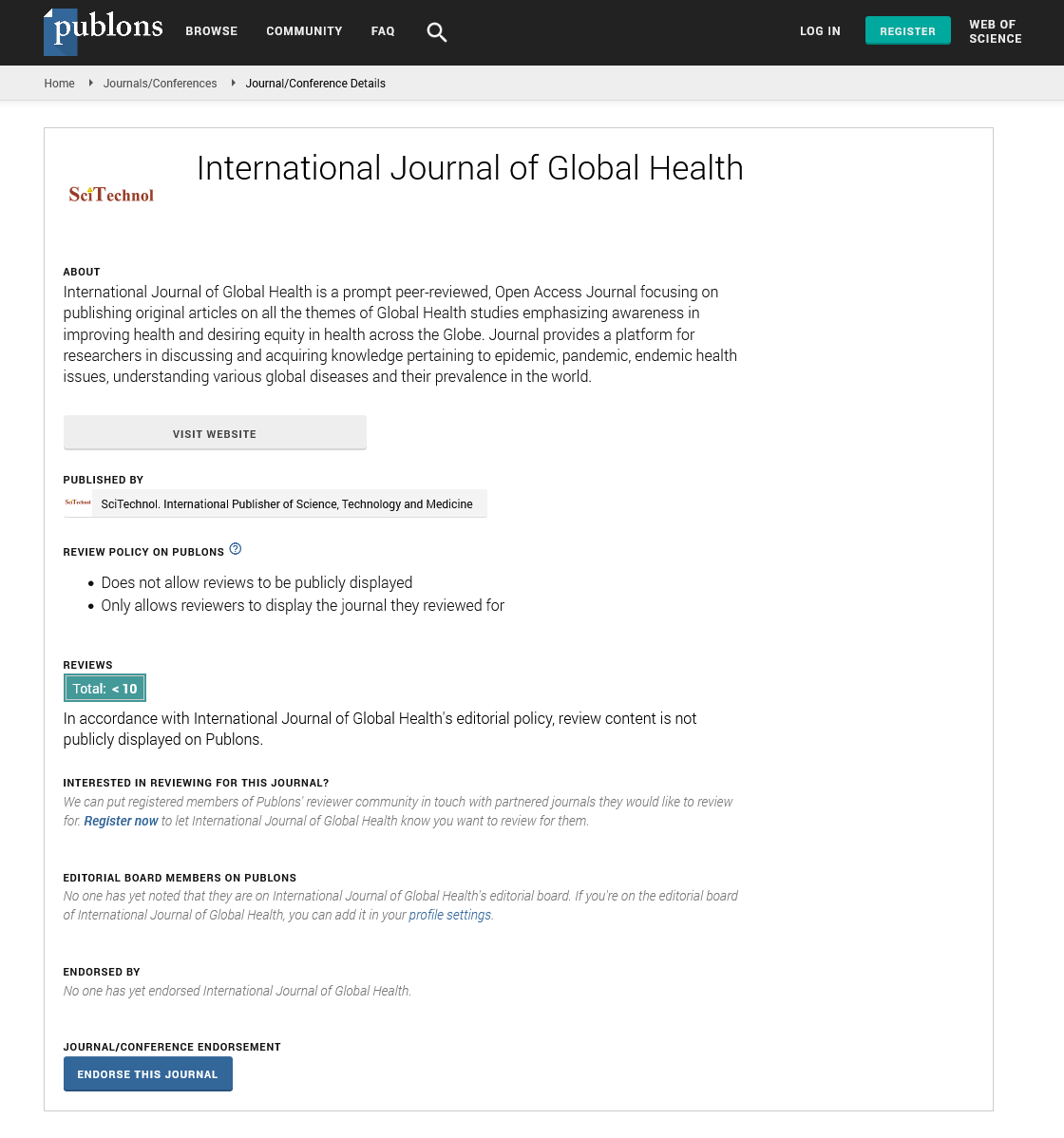Opinion Article, Int J Glob Health Vol: 6 Issue: 3
An Interdisciplinary Strategy to Address Health Inequalities in Urban Environments
Natalia Gonçalves*
1Department of Geography, The University of Hong Kong, Pokfulam Road, Hong Kong
*Corresponding Author: Natalia Gonçalves,
Department of Geography, The
University of Hong Kong, Pokfulam Road, Hong Kong
E-mail: natalia.goncalves@123uhp.hk
Received date: 28 August, 2023, Manuscript No. IJGH-23-116157;
Editor assigned date: 30 August, 2023, PreQC No. IJGH-23-116157 (PQ);
Reviewed date: 13 September, 2023, QC No. IJGH-23-116157;
Revised date: 21 September, 2023, Manuscript No. IJGH-23-116157 (R);
Published date: 29 September, 2023, DOI: 10.4172/Ijgh.1000188
Citation: Gonçalves N (2023) An Interdisciplinary Strategy to Address Health Inequalities in Urban Environments. Int J Glob Health 6:3.
Description
Health inequalities in urban environments pose significant challenges to public health and require comprehensive interdisciplinary strategies for effective mitigation. Cities are characterized by diverse populations, varying socioeconomic conditions, and complex environmental factors that impact residents' health outcomes differently.
Understanding urban health inequalities
Social determinants of health: Urban health inequalities often result from disparities in social determinants of health, including income, education, employment, housing, and access to healthcare.
Environmental factors: Environmental factors, such as air quality, access to green spaces, transportation systems, and neighborhood safety, contribute to health disparities within cities.
Interdisciplinary collaboration: Addressing urban health inequalities requires collaboration among various disciplines and sectors:
Public health and medicine
Health promotion: Public health professionals promote healthy behaviors and access to healthcare services.
Clinical services: Medical professionals provide healthcare services and contribute to disease prevention.
Urban planning and architecture
Urban design: Urban planners design neighborhoods that promote physical activity, reduce pollution, and enhance safety.
Housing: Architects design affordable, healthy, and sustainable housing options for urban residents.
Economics and social sciences
Income inequality: Economists study income distribution and poverty reduction strategies.
Social experts: Social scientists analyze social structures and community dynamics affecting health.
Environmental science and engineering
Air quality and pollution: Environmental scientists monitor air quality and develop strategies to reduce pollution.
Sustainable infrastructure: Engineers design sustainable transportation and waste management systems.
Education
Health literacy: Educators promote health literacy to empower individuals to make informed health decisions.
Youth engagement: Educational institutions engage youth in health promotion and community initiatives.
Key components of the interdisciplinary strategy
Data integration and analysis: Collect and integrate data from various sources, including health records, urban planning data, socioeconomic indicators, and environmental measurements. Apply data analytics to identify health disparities, vulnerable populations, and areas requiring intervention.
Community engagement: Involve community members in decision-making processes to ensure interventions meet local needs. Foster partnerships with community organizations, NGOs, and grassroots initiatives.
Policy development: Collaborate with policymakers to develop and implement evidence-based policies addressing urban health inequalities. Advocate for policies promoting affordable housing, public transportation, and environmental sustainability.
Health promotion: Develop health promotion campaigns targeting specific urban health issues, such as physical activity, healthy eating, and mental well-being. Use culturally sensitive approaches to engage diverse urban populations.
Built environment modification: Implement urban planning changes, such as making walkable neighborhoods, improving public transportation, and increasing access to green spaces. Retrofit existing infrastructure to enhance safety and accessibility.
Healthcare access and equity: Expand access to healthcare services in underserved urban areas. Implement telehealth and mobile clinics to reach vulnerable populations.
Education and training: Provide interdisciplinary training programs for professionals, policymakers, and community leaders. Foster a culture of collaboration and shared knowledge among disciplines.
Measuring progress and evaluation: Establish clear metrics and indicators to monitor the impact of interdisciplinary interventions. Regularly evaluate the effectiveness of policies and programs in reducing health inequalities. Adjust strategies based on data-driven insights and community feedback.
Conclusion
Addressing health inequalities in urban environments demands a multifaceted, interdisciplinary approach that recognizes the interconnectedness of social, economic, environmental, and health factors. Collaboration among public health, urban planning, social sciences, and other disciplines is essential for developing comprehensive strategies that promote equitable health outcomes for all urban residents. By fostering partnerships, engaging communities, and implementing evidence-based policies and interventions, cities can work toward reducing health disparities and developing healthier, more inclusive urban environments.
Description
Health inequalities in urban environments pose significant challenges to public health and require comprehensive interdisciplinary strategies for effective mitigation. Cities are characterized by diverse populations, varying socioeconomic conditions, and complex environmental factors that impact residents' health outcomes differently.
Understanding urban health inequalities
Social determinants of health: Urban health inequalities often result from disparities in social determinants of health, including income, education, employment, housing, and access to healthcare.
Environmental factors: Environmental factors, such as air quality, access to green spaces, transportation systems, and neighborhood safety, contribute to health disparities within cities.
Interdisciplinary collaboration: Addressing urban health inequalities requires collaboration among various disciplines and sectors:
Public health and medicine
Health promotion: Public health professionals promote healthy behaviors and access to healthcare services.
Clinical services: Medical professionals provide healthcare services and contribute to disease prevention.
Urban planning and architecture
Urban design: Urban planners design neighborhoods that promote physical activity, reduce pollution, and enhance safety.
Housing: Architects design affordable, healthy, and sustainable housing options for urban residents.
Economics and social sciences
Income inequality: Economists study income distribution and poverty reduction strategies.
Social experts: Social scientists analyze social structures and community dynamics affecting health.
Environmental science and engineering
Air quality and pollution: Environmental scientists monitor air quality and develop strategies to reduce pollution.
Sustainable infrastructure: Engineers design sustainable transportation and waste management systems.
Education
Health literacy: Educators promote health literacy to empower individuals to make informed health decisions.
Youth engagement: Educational institutions engage youth in health promotion and community initiatives.
Key components of the interdisciplinary strategy
Data integration and analysis: Collect and integrate data from various sources, including health records, urban planning data, socioeconomic indicators, and environmental measurements. Apply data analytics to identify health disparities, vulnerable populations, and areas requiring intervention.
Community engagement: Involve community members in decision-making processes to ensure interventions meet local needs. Foster partnerships with community organizations, NGOs, and grassroots initiatives.
Policy development: Collaborate with policymakers to develop and implement evidence-based policies addressing urban health inequalities. Advocate for policies promoting affordable housing, public transportation, and environmental sustainability.
Health promotion: Develop health promotion campaigns targeting specific urban health issues, such as physical activity, healthy eating, and mental well-being. Use culturally sensitive approaches to engage diverse urban populations.
Built environment modification: Implement urban planning changes, such as making walkable neighborhoods, improving public transportation, and increasing access to green spaces. Retrofit existing infrastructure to enhance safety and accessibility.
Healthcare access and equity: Expand access to healthcare services in underserved urban areas. Implement telehealth and mobile clinics to reach vulnerable populations.
Education and training: Provide interdisciplinary training programs for professionals, policymakers, and community leaders. Foster a culture of collaboration and shared knowledge among disciplines.
Measuring progress and evaluation: Establish clear metrics and indicators to monitor the impact of interdisciplinary interventions. Regularly evaluate the effectiveness of policies and programs in reducing health inequalities. Adjust strategies based on data-driven insights and community feedback.
Conclusion
Addressing health inequalities in urban environments demands a multifaceted, interdisciplinary approach that recognizes the interconnectedness of social, economic, environmental, and health factors. Collaboration among public health, urban planning, social sciences, and other disciplines is essential for developing comprehensive strategies that promote equitable health outcomes for all urban residents. By fostering partnerships, engaging communities, and implementing evidence-based policies and interventions, cities can work toward reducing health disparities and developing healthier, more inclusive urban environments.
 Spanish
Spanish  Chinese
Chinese  Russian
Russian  German
German  French
French  Japanese
Japanese  Portuguese
Portuguese  Hindi
Hindi 
